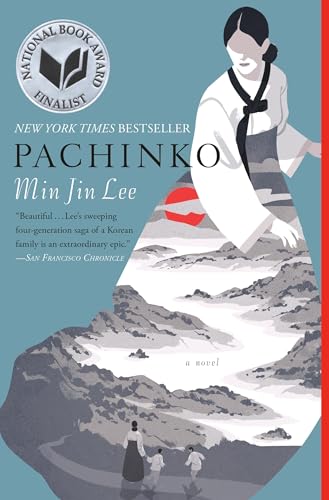Hey everyone, buckle up because today I’ve got a review of Pachinko that’s hotter than a jalapeño in July! Written by Min Jin Lee, this epic generational saga takes us through the Koreans living in Japan. We’ll chat about family dynamics, survival, identity, and why you absolutely need to give this book a shot, even if it does have its tiny flaws.
In a nutshell
“Pachinko” by Min Jin Lee is a compelling historical fiction novel. The book spans over four generations of a Korean family living in Japan. It explores themes like identity, survival, family loyalty, and resilience. It’s a rich tapestry of characters and the historical backdrop of Korea and Japan. The book dives deep into cultural and social issues while keeping you hooked with its complex, engaging story.
Generational Family Saga: A Journey Through Time
Let me tell you, there’s something magical about generational family sagas. They capture the essence of time passing and the resilience of families through thick and thin. A perfect example is Pachinko by Min Jin Lee. I vividly remember reading this book on a rainy weekend, curled up with my cat, Mr. Whiskers. He sneezed halfway through, just as a tense moment was building! I still laugh about it.
Pachinko takes you through the lives of a Korean family over multiple generations. It starts with Sunja, a humble girl from a poor village, who makes a life-changing decision. From then on, the book pulls you into the family’s trials, triumphs, loves, and losses. The way Lee weaves history with personal stories is nothing short of genius. She makes you care about the characters as if they’re real people, even more real than my Uncle Bob who still thinks it’s 1985.
The book’s beauty lies in its honesty. It doesn’t shy away from hardships: poverty, racism, and war. These themes hit close to home for many, making the story relatable on a human level. But hey, it’s not all gloom and doom. There are moments of joy, love, and perseverance that remind us why family matters. I found myself cheering for the characters like they were my favorite sports team. Go team!
Of course, no book is perfect. Pachinko can feel a bit slow at times, like waiting for a pot of water to boil. But oh boy, when it heats up, it really boils over!
Stay tuned for the next section, where we’ll travel to the cultural and historical setting that shapes these unforgettable stories.
Cultural and Historical Setting in Pachinko
When reading Pachinko, I felt like I time-traveled through the streets of Korea and Japan with Linoleum floors and rice paper walls. This book painted a vibrant picture of early 20th-century Korea, a time when the power dynamics and political shifts were as temperamental as my grandma’s mood swings. The author brings to life the rich yet turbulent tapestry of the Korean-Japanese relations, and let me tell you, it’s like watching a family reunion at a wedding where no one remembers the bride’s name.
The historical backdrop serves not just as a pretty diary entry but influences the characters’ lives—much like the day my cousin Jed threw a surprise party and invited my ex-girlfriend. As you read, this historical setting unlocks complexities in socio-economic conditions. It’s like every decision the characters make is a game of dominoes, and they’re all clattering down, making a racket in my head.
In the Pachinko book review, I found that many readers praised the seamless blend of history and culture, likening it to a masterfully cooked stew. But let’s not get carried away. There were times when I felt the narrative got bogged down in history rather than character storytelling. I mean, it’s great that a book can educate you, but I don’t need flashbacks of history class popping up mid-drama.
If you’re a history buff, you’ll find Pachinko a goldmine; if not, well, it’s more like a treasure hunt where the map’s in a foreign language. Next, we’ll tackle the quirky and rich character development, where we’ll see if they earn their keep or just collect dust on the bookshelf.
Character Development in Pachinko
Oh boy, where do I start with the character development in Pachinko? This book has more layers than my aunt’s lasagna (and trust me, that lasagna is legendary). Min Jin Lee crafts characters that stick with you like glue. From Sunja, the plucky heroine, to the ever-complicated Hansu, everyone has a story worth telling.
What really stands out is how each character feels real. They evolve, adapt, and sometimes break. Sunja starts off as this innocent girl and turns into a strong woman who takes no nonsense. It’s like watching your little sister grow up, only with more drama and kimchi.
And let’s not forget the second and third generations. Noa and Mozasu, Sunja’s sons, are different as night and day. Noa is studious and wants to fit in, while Mozasu takes a different path. Their struggles and triumphs tug at your heartstrings. It’s like you’re rooting for your favorite player in a game, but the stakes are life and identity.
Hansu, the mysterious and ever-enigmatic figure, adds a bit of spice to the story. He’s the guy you love to hate but can’t ignore. And other supporting characters? They’re no extras. Each one adds depth and flavor, much like the pickled side dishes that complete a Korean meal.
In the next section, we will journey into the themes of survival and identity, the lifeblood of this incredible saga. Strap in, it’s gonna be a wild ride!
Themes of Survival and Identity in Pachinko
Survival and identity run deep in Min Jin Lee’s Pachinko. They pulse through the veins of the characters like that extra shot of espresso you regret at midnight.
The novel follows four generations of a Korean family living in Japan. Their struggle to survive and find their identity gets tougher than untangling earphones. From Sunja, the matriarch, who starts her journey amid poverty and war, to her grandchildren grappling with their place in society, survival and identity are not just themes—they are life itself. Each page turns like a game of Jenga; you never know what will topple next.
Identity is a battle. The family’s Korean roots get them marked as outsiders. It’s like wearing socks with sandals—just doesn’t fit in. Noa faces this battle head-on, struggling with his Korean heritage in Japanese society. His attempts to blend in remind me of that time I tried to fit into skinny jeans—uncomfortable and bound to fail.
Survival is not just physical but emotional. Life throws curveballs, and the characters dodge them like they’re in the Matrix. Sunja’s iron will, Hansu’s cunning, and even Mozasu’s struggle to find his path paint a vivid picture of resilience. They make you think, ‘Could I survive that?’ Spoiler alert: probably not.
Do I recommend Pachinko? Absolutely. It’s like a rollercoaster—you’ll scream, you’ll laugh, you’ll cry, but you’ll be glad you got on.
Conclusion
Wrapping up this wild ride, ‘Pachinko’ is a touching saga that lives in your head rent-free. From Sunja’s strength to the generational struggles, Min Jin Lee crafts a vibrant picture of a family’s survival and identity in a hostile world. Sure, it’s long and sometimes heavy, but trust me, it’s worth every minute. If you love family drama and historical tales with a dash of heartache and joy, grab ‘Pachinko’. And now, this concludes the review. Happy reading!


